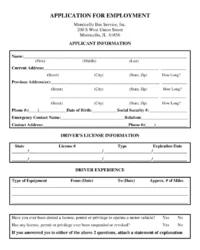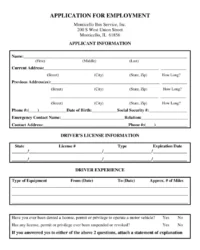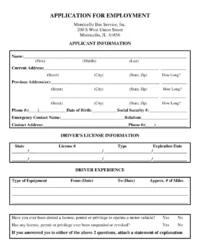Using such a structure offers several advantages. It ensures applicants present necessary information in a clear, organized manner, increasing the likelihood of a thorough review by hiring managers. Furthermore, a well-crafted document can showcase an applicant’s understanding of industry requirements and professionalism, potentially setting them apart from other candidates. This streamlined approach also saves applicants time and effort, allowing for focused customization based on specific job requirements.
This resource delves further into the key components, best practices, and specific examples relevant to crafting a compelling application for various roles within the transportation industry.
Key Components of a Transportation Job Application
Effective applications within the transportation sector share several crucial components, ensuring clear communication of qualifications and experience to potential employers.
1. Contact Information: Accurate and up-to-date contact details are essential. This section typically includes full name, phone number, email address, and sometimes a physical address. Professional email addresses are recommended.
2. Summary/Objective Statement: A brief overview of career goals and key qualifications relevant to the target position provides immediate context for the hiring manager.
3. Work Experience: Previous employment history should be presented in reverse chronological order, listing company name, dates of employment, job title, and a concise description of responsibilities and achievements. Emphasis should be placed on experience relevant to transportation, logistics, or related fields. Quantifiable achievements, such as safety records or efficiency improvements, are particularly valuable.
4. Skills Section: This section highlights specific skills relevant to the desired position. Examples include specific vehicle operation endorsements (CDL Class A, etc.), knowledge of transportation regulations, proficiency with GPS and navigation systems, or experience with logistics software. Technical skills related to vehicle maintenance or repair might also be included.
5. Certifications and Licenses: Relevant certifications, such as commercial driver’s licenses (CDLs), hazardous materials endorsements, or safety certifications, should be clearly listed with their respective issue and expiry dates.
6. Education: Educational background, including high school diploma/GED and any relevant post-secondary education or vocational training, should be listed. Emphasis should be placed on training relevant to the transportation industry.
7. References: Providing a list of professional references who can attest to one’s skills and work ethic is often requested. It’s important to obtain permission from individuals before listing them as references.
A comprehensive application incorporates these elements, presenting a clear and concise overview of qualifications, maximizing the potential for securing an interview and ultimately, employment within the transportation sector.
How to Create a Transportation Job Application Template
Creating a robust application template streamlines the application process for transportation-related jobs. A well-structured template ensures consistent presentation of qualifications and facilitates customization for specific roles.
1: Choose a Format: Select a widely accepted document format like Microsoft Word (.docx) or a portable document format (.pdf). This ensures compatibility across various devices and operating systems.
2: Structure the Template: Organize distinct sections for contact information, a summary/objective statement, work experience, skills, certifications and licenses, education, and references. Clear headings and consistent formatting enhance readability.
3: Craft Placeholder Text: Within each section, insert placeholder text to guide content entry. For instance, in the work experience section, indicate where to list company name, dates of employment, job title, and responsibilities. This placeholder text serves as a prompt for users to replace it with their specific information.
4: Design for Clarity: Employ a clean and professional font, such as Times New Roman or Calibri, in a readable size (10-12 points). Maintain consistent spacing and margins for a polished appearance.
5: Emphasize Industry Relevance: Ensure the template emphasizes areas crucial for transportation roles. This includes sections for specific certifications (CDL, HAZMAT), safety records, and specialized skills related to vehicle operation or logistics.
6: Tailor for Different Roles: Consider creating separate templates tailored to different job types within the transportation sector (e.g., truck driver, dispatcher, logistics coordinator). This allows for focused highlighting of relevant skills and experience.
7: Review and Refine: Before widespread use, thoroughly review the template for clarity, completeness, and accuracy. Test its usability by populating it with sample data to ensure all sections function as intended.
Developing a comprehensive template provides a foundation for creating compelling job applications within the transportation industry, allowing applicants to present their qualifications effectively and efficiently.
A well-crafted, industry-specific document serves as a crucial tool for individuals seeking employment within the transportation sector. It provides a structured framework for presenting qualifications, experience, and certifications relevant to diverse roles such as truck drivers, dispatchers, and logistics coordinators. By utilizing such a resource, applicants can streamline the application process, highlight key skills, and effectively communicate their value to potential employers, thereby increasing their chances of securing a desired position.
In a competitive job market, a targeted and professional application can be the differentiating factor. Careful consideration of industry-specific requirements and meticulous presentation of relevant qualifications contribute significantly to career advancement within the dynamic and essential field of transportation.


